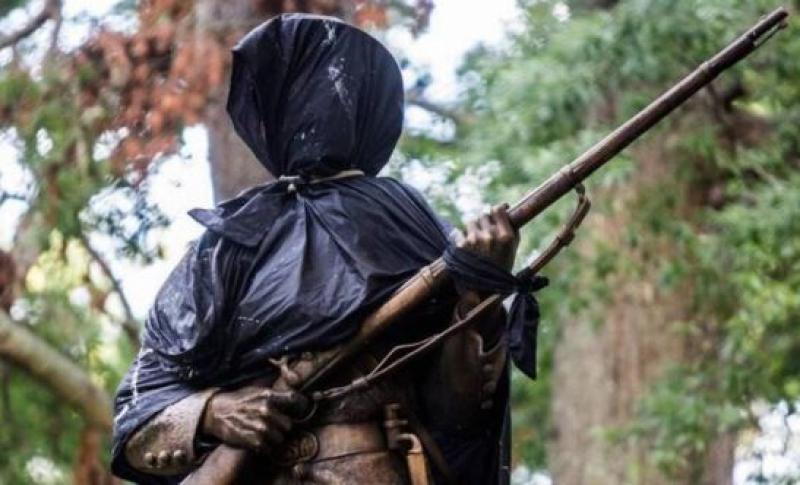Silent Sam and other Civil War monuments rose on race



Silent Sam and other Civil War monuments rose on race
Op-Ed
November 27, 2017
By Brian K. Fennessy
======================================================================
In the debates over Chapel Hill’s Confederate monument, scholars and activists frequently cite Julian Carr’s 1913 dedication speech. Carr argued that “during the four years immediately succeeding the war,” the Confederate soldier’s “courage and steadfastness saved the very life of the Anglo Saxon race in the South.” Carr placed the monument in a larger context than the Civil War. In the late 1860s, Reconstruction created non-racial, national citizenship and inspired local challenges to white supremacy. However, violent resistance by former Confederates overthrew Reconstruction in the 1870s, and at the turn of the twentieth century, white supremacists used disenfranchisement to quash further biracial activism. Carr celebrated the defeat of Reconstruction, the subsequent victory of white supremacy and the Confederate veteran’s role in both. But just how common was Carr’s decision to bring up race and Reconstruction at a monument to the ordinary Confederate soldier?
To answer this question, I searched for dedication speeches that were given at Confederate soldier monuments across North Carolina. Most orations were given by veterans and state officials. I successfully tracked down 30, and they support two conclusions: 1) white nationalism was a fixture of Confederate monumentation, and 2) Confederate soldier monuments honored veterans for their postwar success in eroding black equality as much as for their failed wartime sacrifices.
Racist language pervades the dedication speeches. If one assumes that the speaker is excluding blacks from the term “southerners,” when its use clearly meant only white southerners, then white identity politics are present in every speech. But speakers were often more explicit. 14 speeches explicitly invoked “our Anglo-Saxon ancestors,” “love of race,” or “your own race and blood.”
In front of Charlotte’s common soldier monument, dedicated in 1910, Judge Armistead Burwell admonished his audience to “be reminded by this silent soldier ... to protect from taint the Saxon blood that courses in your veins.” Eleven years later, in Caswell County, Chief Executive of the North Carolina Daughters of the Confederacy Mary Kerr Spencer declared, “We are proud of the fact that North Carolina has the finest and purest strain of Anglo-Saxon blood in the veins of her people on the American continent.” At a 1909 dedication, Gov.William Kitchin extolled whites for their subjugation of black Americans, Central Americans, Asians, Africans and Native Americans. In this project of global racial ordering, he proudly proclaimed, “the Confederate veteran has had his full share.”
Reconstruction was another recurrent theme. Thirteen of the speeches described the postwar period. Orators spun a narrative of Reconstruction as a tragic era of misrule stemming from black suffrage. Carr alluded to Reconstruction as the time “when ‘the bottom rail was on top,’ ” suggesting – incorrectly – that former slaves had become politically dominant. Confederate veteran John C. McLauchlin tapped into a deeper anxiety at the Wadesboro monument. He said that during Reconstruction “our homes were not inviolable, our women were not secure from the assaults of the brutish,” conjuring up the white nightmare of black rapists.
People at the time disputed this interpretation, and historians have thoroughly discredited it. Nevertheless, it was a story that white supremacists used to justify disenfranchisement and imagine Confederate veterans as heroes. At the dedication of the Pittsboro soldiers’ monument in 1907, Judge Walter Clark told fellow veterans “in the years following (the war) you were equal to the highest duties of the citizen.” Gov. Thomas Bickett told a Rocky Mount audience in 1917 that “the example of the heroism and fortitude of the Confederate soldier has been worth more since the war was over than the war cost.” Kitchin was “glad the leaders in war had become the leaders in peace.”
Monuments to the common Confederate soldier were inseparable from white nationalism. They were built to celebrate veterans’ successful efforts to circumscribe black citizenship, and dedication speakers wanted those actions to inspire others. D.H. Hill Jr., son of a famous general, even went as far as to say proudly and without irony, “We are all slaves of the dead. Because men who lived before us did certain things we continue to do them.” Shall we continue to be slaves to the dead? Or perhaps we should listen to Osborne Lochrane, a Georgia Confederate who actually supported Reconstruction, when he said in late 1865, “Let not pride, prejudice and folly blind us and lead us stumbling backward over a wilderness of graves to meet the embrace of death; for we must be men, not monuments.” Living people change, but monuments do not.
Brian K. Fennessy is a history Ph.D. candidate at the University of North Carolina at Chapel Hill. His dissertation is on Reconstruction politics.
Protesters who want Confederate monuments removed from state grounds chant outside the building after the N.C. Historical Commission voted to delay action on a recommendation about removing statues from state sites during a meeting at the Archives and History Building in Raleigh, NC, on Sept. 22, 2017. Activist on both sides of the issue were present at the meeting. Chris Seward cseward@newsobserver.com






There is much more evidence than this article that Confederate monuments were dedicated in the spirit of white supremacy. How much "evidence" do we need? Yet I bet not one in one hundred supporters of confederate monuments know or care the history of them.
This is why we need something like the 1619 Project.